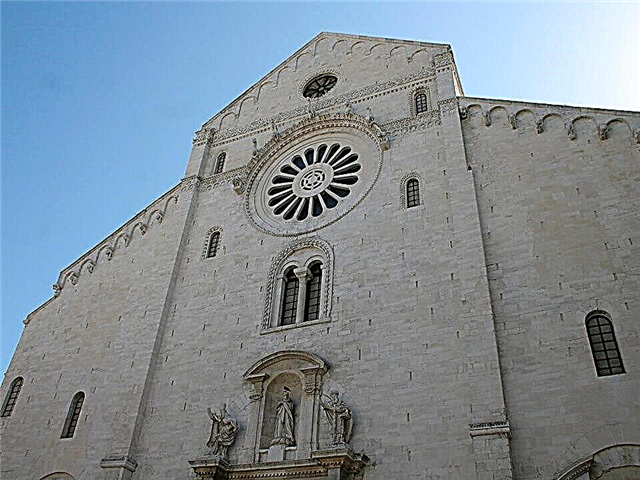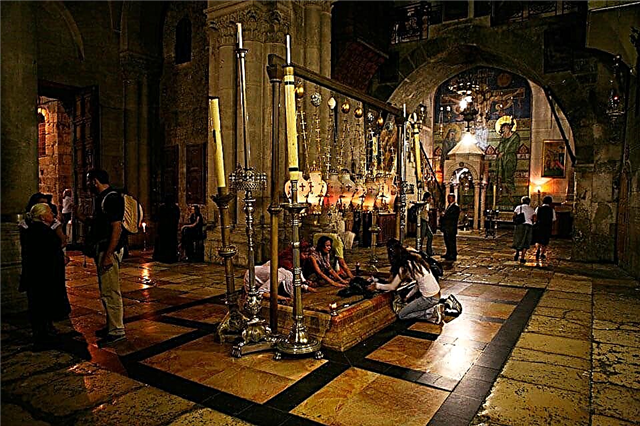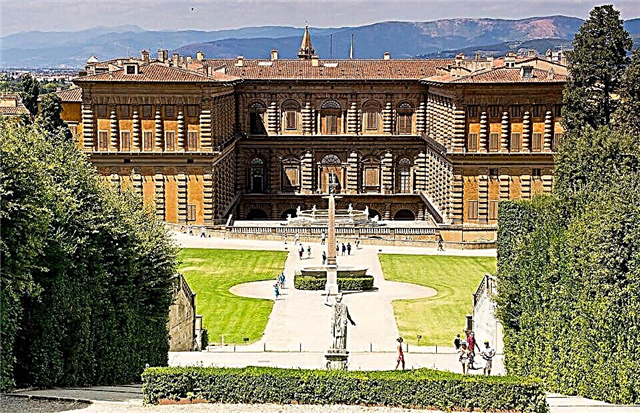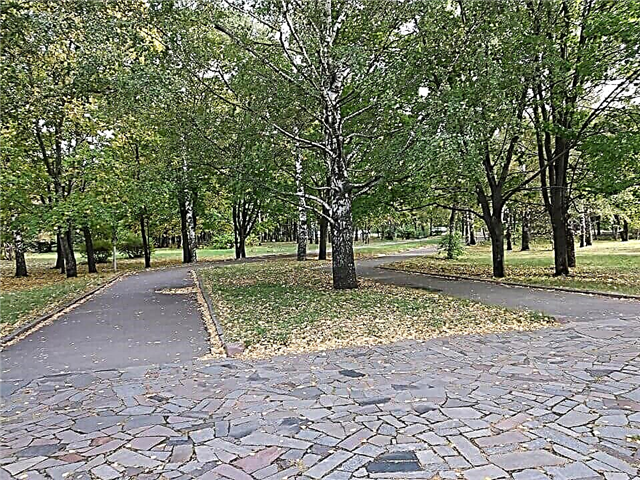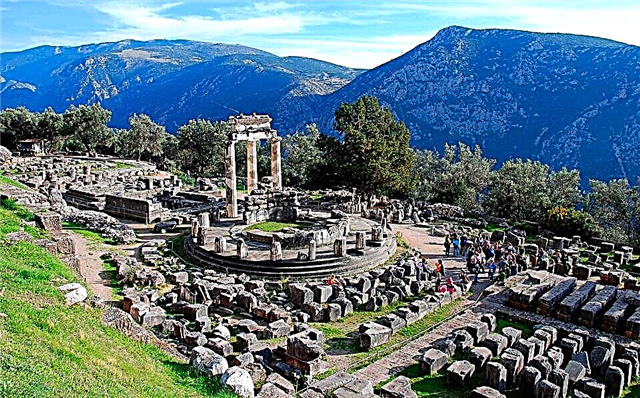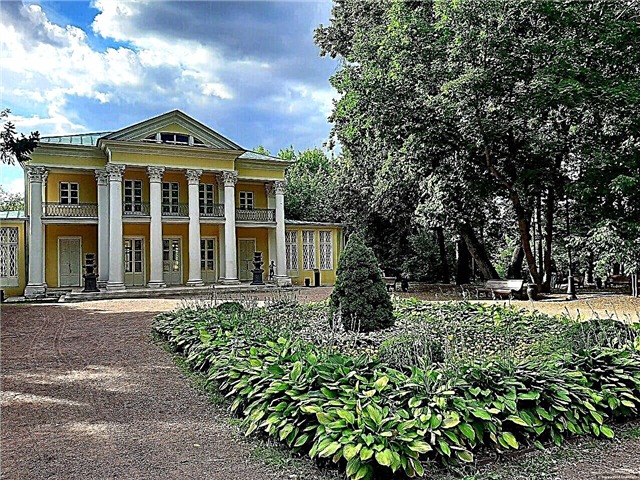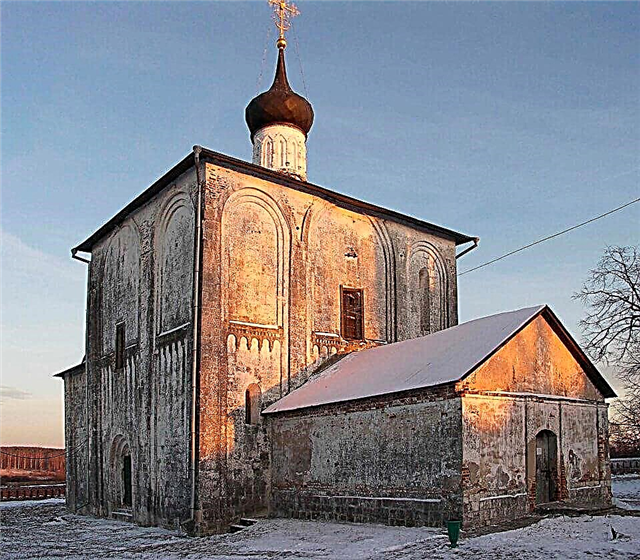A small town in the Vladimir region to this day has preserved not only the buildings of past eras, but also the extraordinary atmosphere of a quiet old Russian city. The sights of Suzdal can be viewed for more than one day. There are a huge number of temples, and around the city there was once a ring of monasteries, many of which have survived almost in their original form.
Suzdal Kremlin
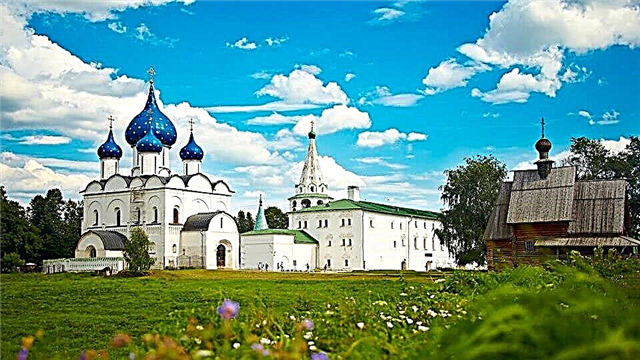
The history of the city begins from this place. The Suzdal Kremlin was built in the X-XII centuries, and almost all of its buildings have survived to this day, except for the defensive walls and towers. The Kremlin performed a protective function - it saved the city from the enemy from three sides: east, west and south.
In the north, the Kamenka River flowed, which also blocked the enemy's path. On all sides the Kremlin was surrounded by ditches and earthen ramparts, more than a kilometer long. Walls with observation and protective towers and gates were installed on them. Their ruins have survived to this day.
On the territory of the Kremlin there was a princely court and a squad. It was the center of the city's political, spiritual and cultural life. All the main sights of the Kremlin are associated with religion.
Several of the oldest cathedrals and churches have survived here, as well as household and residential buildings - the Bishops' Chambers. You can visit the complex from 10 am to 6 pm every day, except Tuesday. And on the last Friday of the month they arrange a cleaning day.
Theotokos-Nativity Cathedral
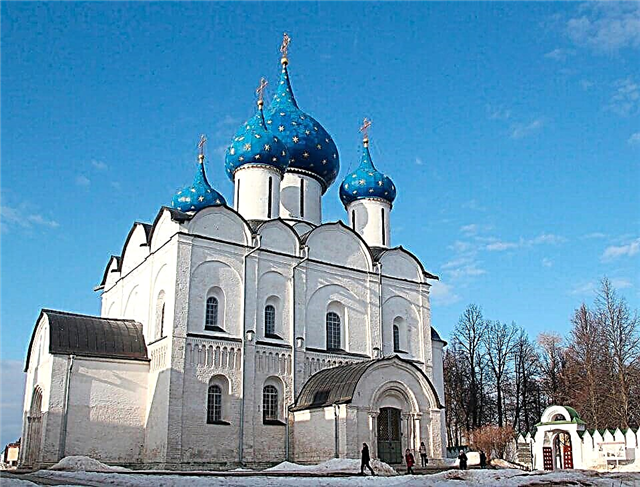
The Cathedral of the Nativity of the Virgin was built in the 13th century during the reign of Prince Yuri Vsevolodovich on the site of the Assumption Cathedral, which is considered the first Orthodox church in the city.
It was rebuilt many times during the reign of Yuri Dolgoruk and Vsevolod the Big Nest. The new temple was built in just three years. It was illuminated on September 21 - the day of the Nativity of the Most Holy Theotokos, and it was decided to dedicate the cathedral to this. This is the oldest surviving Kremlin building.
The majestic building is lined with thin bricks and lined with limestone slabs. Ornamental carvings run along the façade, and the interior is decorated with frescoes by Byzantine icon painters and a multi-colored tiled floor. The cathedral went through many shocks, but every time it was restored.
In the 20s of the last century, the service here ceased, the temple received the status of a museum along with the entire complex of the Kremlin. In the 90s it was returned to the believers. The cathedral is included in the UNESCO World Heritage List.
Wooden Nikolskaya Church
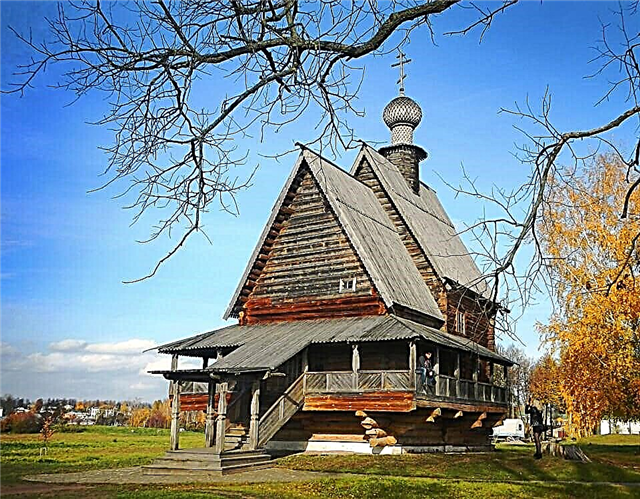
The wooden St. Nicholas Church is adjacent to the Cathedral of the Nativity of the Virgin. It was built in Glotovo - a small village in the Yuryev-Polsky district in about 1766. The church was built without a single nail and is a unique monument of ancient Russian wooden architecture.
The shape resembles a simple village house, consisting of two log cabins, surrounded by a covered gallery. The roof is topped with a traditional wooden onion. The church was insulated; winter services were held here.
However, during the Soviet years, it stood abandoned and gradually collapsed. In the 60s of the last century, an employee of the Suzdal Museum, historian A. Varganov moved the building to the territory of the Suzdal Kremlin.
For this, the building was completely dismantled and reassembled on the site of the old Church of All Saints, which burned down during a fire in the 18th century. Nikolskaya Church became the first exhibit of the Museum of Wooden Architecture.
Assumption Church
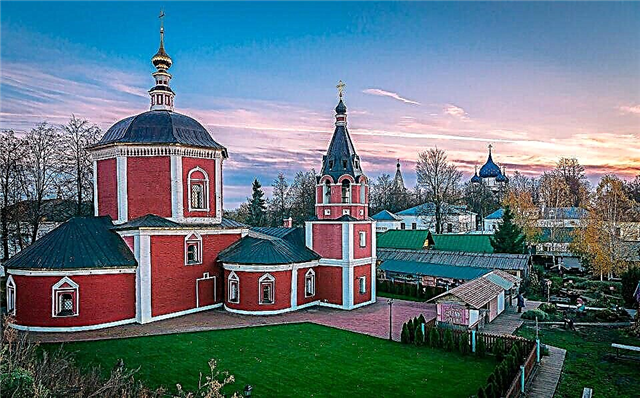
Elegant, bright red with white pilasters and platbands, the Assumption Church is the only building that has survived from the former prince's court. It is located immediately behind the former rampart, on the river bank.
In the 15th century, the courtyard of Ivan III stood here. The Assumption Church, which was still wooden at that time, is listed in the documents as the courtyard church of the prince's estate.
Later, around 1650, a stone temple was built in its place. Once the church had a bell tower and a warm side-chapel of Sergius of Radonezh and his disciple Nikon. The temple was surrounded by a low fence with stone pillars and gates.
In the 20s of the last century, the bell tower and the side-chapel were destroyed, as the administration of the prison for political prisoners located in the Spaso-Evfimievsky Monastery needed a brick. As a result, part of the Assumption Church was dismantled.
Misha Balzaminov's house
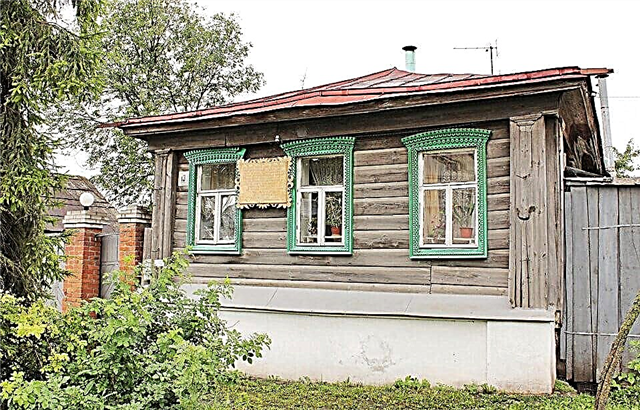
The old house on Staraya Street was bought by Fyodor Firsov from a saddler in 1925. His family lived here and a simple, but profitable business was established: Fyodor baked and immediately sold rolls.
Business was going well, and his family did not feel the need. In 1964, the Firosvs agreed to provide their house and yard for the filming of The Marriage of Balzaminov. Since then, this house has invariably been associated with the image of Misha Balzaminov.
Almost all of the interior scenes were filmed in the Mosfilm pavilions, but the courtyard and all the buildings are very easy to recognize. Near the house, the film crew built a dovecote, borrowing birds for filming from local boys. Over time, the house collapsed heavily, which is why its first floor became semi-basement.
The fence was painted in a new way and the platbands were altered, but the building can still be recognized, especially since there is now a plaque on the facade reminding that the famous comedy was filmed here.
The Wax Museum
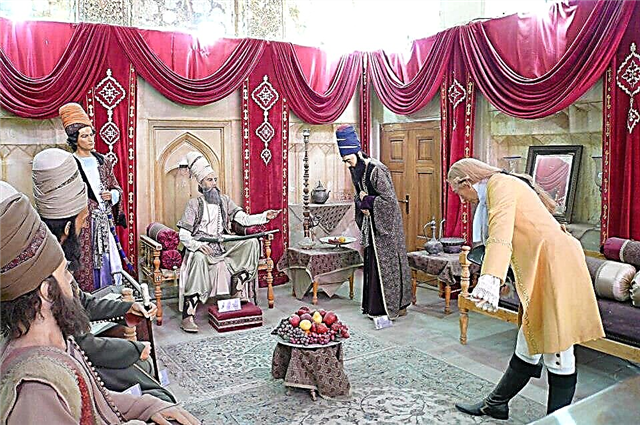
In fact, the Museum of Wax Figures is the first Moscow exhibition of such sculptures. At that exhibition, only 9 figures were presented, depicting members of the government of the Soviet state. Today, in three halls of the museum, one can trace the history of our country in persons from the 9th to the 20th centuries.
In the first hall, the main figure is the Baptist of Russia, Prince Vladimir. The next hall is dedicated to Russian tsars and emperors - Ivan the Terrible, Peter I, Catherine II, as well as our great generals.
The following are Russian writers and poets, enlighteners of the golden age of Russian literature - Pushkin, Turenev, Dostoevsky, Tolstoy, etc.
Modern times are represented by the figures of Stalin, Churchill and Roosevelt during the Yalta Agreement, as well as the famous trinity from Gaidai's comedies - Coward, Goonies and Experienced.
Nativity of Christ and Nikolskaya churches
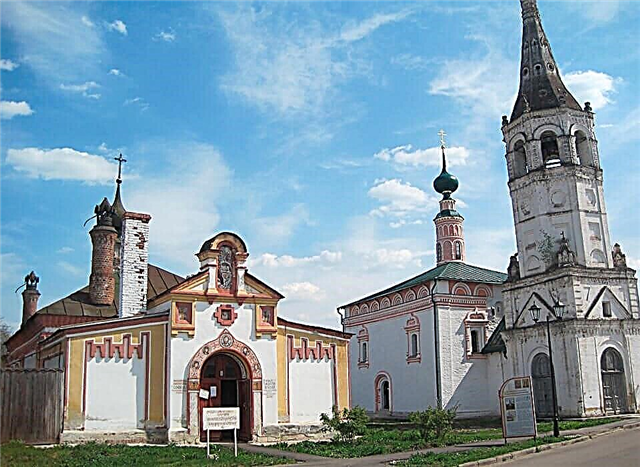
One of the most revered saints in Russia - Saint Nicholas has always been considered the patron saint of travelers, therefore a church dedicated to him was built next to the ancient Nikolsky gate not far from the rampart in the southeastern part of Detinets in 1720-1739 on the site of the church that burned down in 1719 ...
The architect was an unknown Suzdal master. In the last quarter of the 17th century, a winter Nativity of Christ church was added to it.
The beautiful, richly decorated building consists of a main building and a bell tower, which are connected by a refectory. This building is one of the hallmarks of the city. He can be recognized in one of the episodes of the film "The Marriage of Balzaminov".
Since 2007, an icon-painting workshop has been operating at the church, headed by the rector of the church, Andrei Davydov. Master classes are held here, where you can get acquainted with the basics of fresco painting and encaustics. The works of Andrei's father are also exhibited here.
Museum "Shchurovo Settlement"
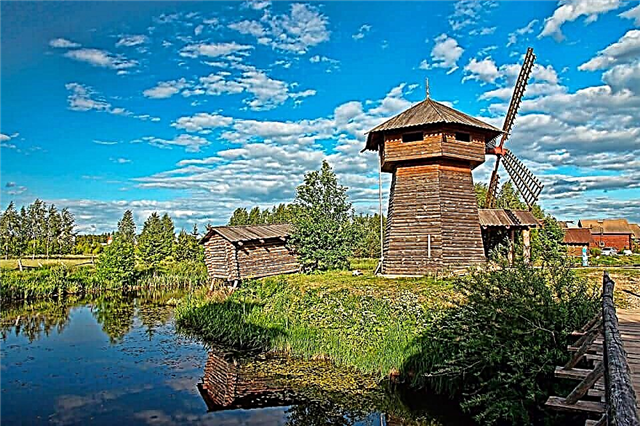
A unique museum will help anyone who wants to feel like a resident of Russia in the past. Here are collected not only architectural structures characteristic of the time when Yuri Dolgoruky or Vsevolod the Big Nest ruled in the Vladimir-Suzdal principality.
The basis was made up of the scenery used for the filming of Pavel Lungin's film "Tsar". On the territory of the museum there are wooden huts and dugouts, in which the ancient Slavs lived, forges, a corral for cattle, a field kitchen of the prince's squad, an arms workshop.
Here they teach how to saddle and control a horse, shoot a bow and fight with swords, like Russian knights, and women - bake a loaf in a real oven.Children will be able to feed rabbits and kids, chat with other pets, and find out what games their peers were playing at that time. Reconstructions of historical events, including famous battles, are arranged here. The museum is open only on weekends; it is better to book excursions in advance.
Spaso-Evfimiev Monastery
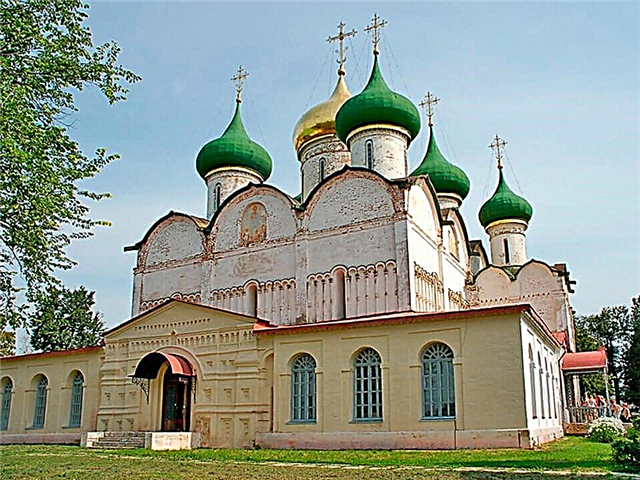
This monastery on the banks of the river was founded in 1352. He received his name after his first abbot Euthymius was canonized.
During the Polish-Lithuanian invasion, in the troubled 17th century, the monastery was plundered, its wooden buildings burned down. After that, powerful walls with defensive and watchtowers were erected around. By the end of this century, it had become one of the largest Russian monasteries.
Already under Catherine in 1766, political criminals and mentally ill prisoners were sent here. After the revolution, an isolation ward for political criminals was located here, then a filtration camp and a correctional labor colony for minors. The monastery received the status of a museum only in 1968 and today it is part of the Vladimir-Suzdal Museum-Reserve.
Posad house
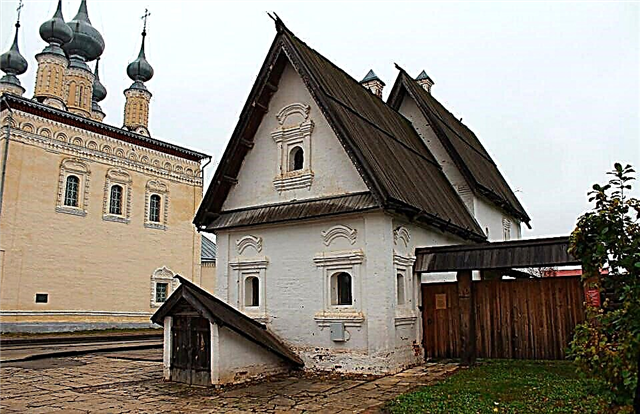
This is one of the first examples of civil engineering. Until the beginning of the 16th century, all private houses were built mainly of wood. Brick was more expensive and for many such buildings were beyond the means. It is to this period that the posad house belongs.
The name of the architect remains unknown, but information about the first owners of the house has been preserved. At first, his owner was Koska Dobrynka, a tailor, and then he moved to the Bibanov family, who had their own tavern and kalachnaya.
In the 19th century, the house was bought by the merchant Boldin. In 1970, the building was transferred to the Vladimir-Suzdal Museum, where the interiors of residential buildings of the 16th-17th centuries were restored. Guests can see how ordinary citizens lived, where they stored supplies and clothes, received guests, slept.
There are several rooms in the house - utility rooms: a cold canopy and a closet, where food was stored, and living rooms - upper rooms, which were located on the first and second floors.
Monastery of the Robe
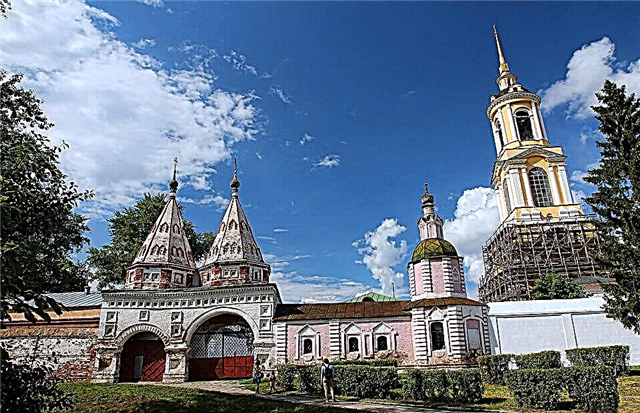
According to scientists, the monastery was founded in 1207 and is one of the oldest not only in Suzdal, but in Russia in general. Unfortunately, the first buildings were wooden and did not survive numerous fires and attacks.
Stone buildings began to be erected in the 16th century, and they are perfectly preserved. The most magnificent of them is the Cathedral of the Robe Deposition. Next to it is the 72-meter tower of the Venerable Bell Tower, which was erected in 1812 in honor of the victory in the Patriotic War.
The Sretenskaya refectory church also dates from about the same time. Once on the territory of the Monastery of the Robe, the female Trinity monastery was located. The Trinity Monastery was destroyed in the 30s of the last century. Only the Holy Gates remained from him. During the Soviet years, the monastery was closed, and a power station was located here. In the 90s it was returned to the believers.
Vasilievsky monastery
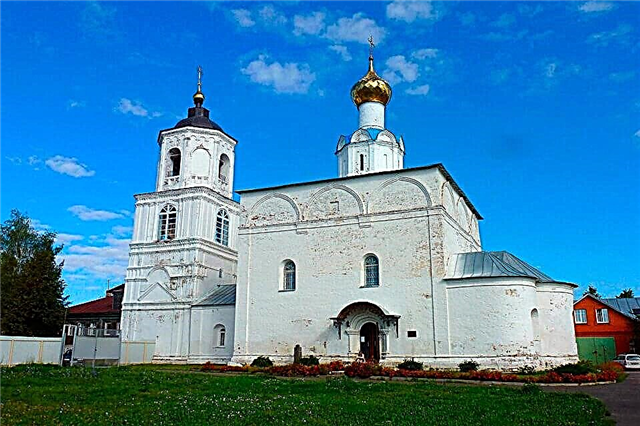
On the outskirts of the city, on the way to Kideksha, at the direction of Vladimir, Krasnoe Solnyshko, this monastery was founded in the 13th century. He performed not only a spiritual function, but also served as an additional defensive structure.
According to legend, it was in the wooden church of the Vasilievsky Monastery that the people of Suzdal adopted Orthodoxy. The monastery itself bore the name of the heavenly patron of Prince Vladimir, who bore the name of Vladimir in baptism. This church has not survived, like the rest of the wooden buildings.
In the 17th century, white stone walls and temples were erected in their place. The Sretenskaya Church, Vasilievsky Cathedral and the Holy Gates have survived to this day. In 1916 this monastery became a women's monastery, but in 1923 it was closed.
During the Soviet years, it housed warehouses. In the 90s, the monastery began to operate again, only now it has become a man's. Today the monastery has a small hotel where pilgrims usually stay, but ordinary tourists can also visit the monastery.
Alexander monastery
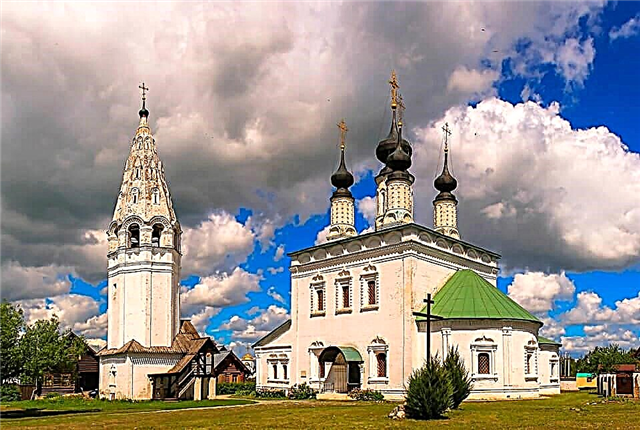
Back in 1240, this convent was founded by Alexander Nevsky, but nothing has survived from those buildings - during the years of the Polish-Lithuanian expansion of 1608-1610, everything burned down. At the end of the 17th century, at the expense of Natalya Naryshkina, the mother of Peter I, the Church of the Ascension was restored, and later other buildings, a bell tower and low monastery walls with towers were built.
The holy gates resemble those that stand in the Monastery of the Robe, they were erected at approximately the same time and according to the same principle. By decree of Catherine in 1764, the monastery was abolished, since then the Church of the Ascension has become an ordinary parish for the townspeople.
In Soviet times, it was closed. In 2006, novices again appeared in the monastery. Now there is a small male monastery in which 5 monks live. Unlike other monasteries and temples, tourists are not so often here, so it is always quiet and calm.
Pokrovsky monastery
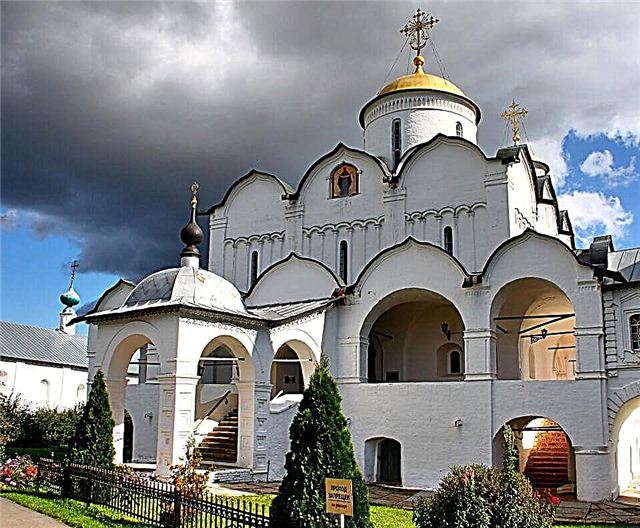
This convent, founded in the XIV century, is one of the most mystical and mysterious places. He was a witness to dramatic events, and for many centuries it was used as a link and prison for women of the highest circle.
They sent here to objectionable and simply annoying princesses and queens. For such nuns, not only special cells were built, but also crypts for future burial. The main Pokrovsky Cathedral and the majestic bell tower, the refectory, the Holy Gates and numerous outbuildings have been preserved on the territory of the monastery.
The ordered hut with a punishment cell has also survived to this day, in which women who fell out of favor were kept. After the revolution, the monastery was closed. A hotel with a restaurant, a concert hall and a bar was set up here. The monastery was returned to the church in 1992. Now all of its premises, except for the rooms in which the nuns live, are open to tourists.
Fire Tower
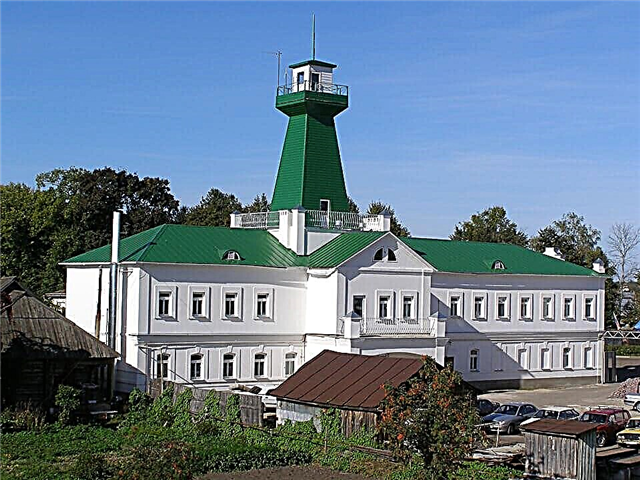
In 1864, a fire brigade was created in the city. It was located in the building of a former stable and had only one hand pump in its arsenal. In 1890, a fire tower was finally built in the city, from which the entire city was viewed.
Since then, the fire brigade has been located here in the building on the first floor. Over time, it became badly dilapidated and was practically in disrepair. Only at the beginning of the 20th century, through the efforts of the city's fire service, it was possible to find funds for the restoration of the building.
It was decided to restore the building in the form in which it was built. To do this, they used the drawings stored in the archives of the Suzdal Museum. At the end of 2005, firefighters moved into a new building that meets all modern requirements and at the same time harmoniously fits into the overall historical appearance of the city, being its decoration.
Peter and Paul and Nikolskaya churches
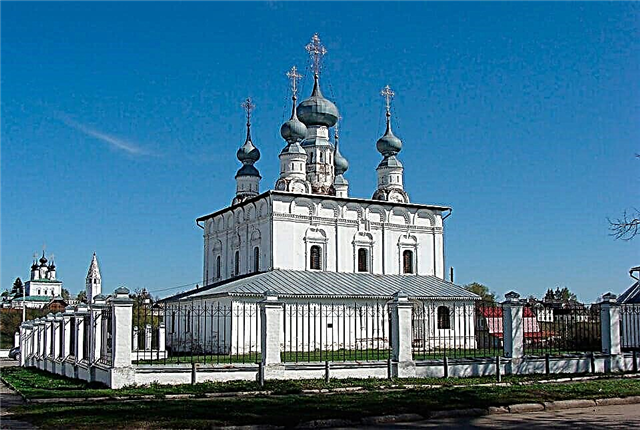
In 1694, Metropolitan Hilarion blessed the construction of a church in honor of the Holy Great Martyrs Peter and Paul. The church was built thanks to the diligence of the novices of the Intercession Monastery. According to rumors, the idea of its construction belongs to Evdokia Lopukhina, the first wife of Peter I, who was exiled to the Intercession Monastery and lived there for 20 years.
One of the chapels of the temple was consecrated in honor of Alexy, the man of God, in memory of the murdered prince. In the 19th century, the throne of St. Mitrophany was organized in the church at the expense of the city dweller Ekaterina Petrova.
The majestic five-domed church was the size of a cathedral. Once a bell tower was adjacent to it, which was completely destroyed. In 1712, the summer church was supplemented with the winter church of St. Nicholas. This is the first warm church in the city.
Later, the construction of paired churches became traditional for Suzdal and other cities. It is a small temple with a very simple and laconic design.
Elias Church
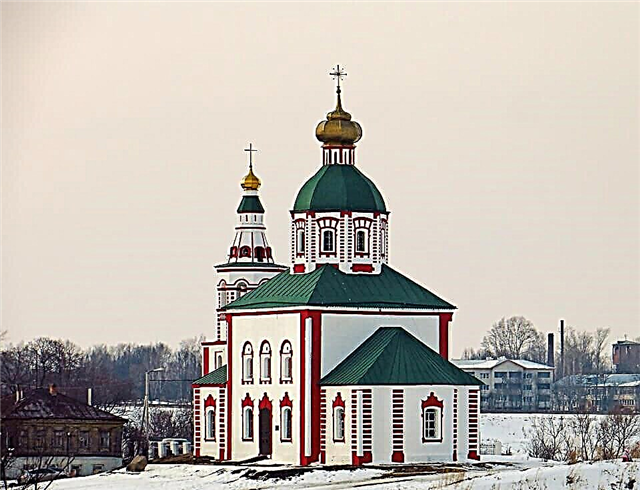
Opposite the Kremlin, on the bend of Kamenka, on the reserved Ilyinsky meadows, in 1744, a stone church was erected in honor of Ilya the Prophet. Once there was a bishop's settlement and a wooden church.It was decided to build a new temple on a dais - Ivanova Hill.
It was built in the style traditional for the 18th century - a pillarless quadrangular structure is crowned with one chapter on a drum mounted on an octagon. In addition to the main building, a refectory and a bell tower were added to it, and later a winter church in honor of John the Theologian was completed.
But during the years of Soviet power, the Ivanovo church, the refectory and the bell tower were destroyed. The temple suffered greatly during this time, and the restoration, the project of which was developed back in the 70s, dragged on for many years. Only in 2010, the bell tower and the refectory were recreated, practically returning the Elias Church to its original appearance.
Museum of Wooden Architecture
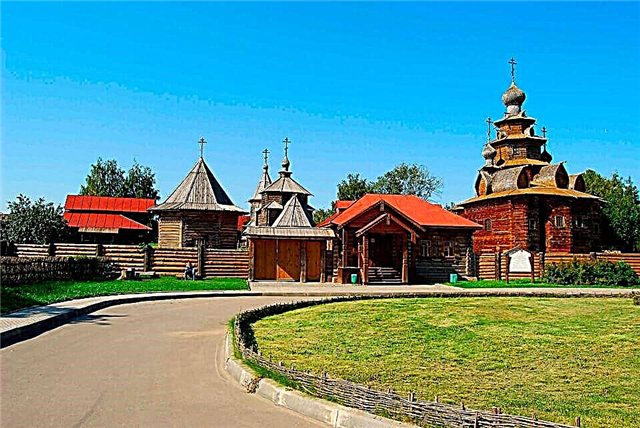
The amazing open-air museum will acquaint you with unique examples of ancient wooden architecture and help you imagine how our ancestors lived in the 17th-18th centuries. All exhibits were collected in the villages and villages of the Suzdal region, dismantled by logs and restored already in place.
Here you can see a merchant's house, outbuildings, mills, a well-to-do peasant's house. You can enter each hut. The museum staff completely recreated the life of a peasant or a merchant family of that time: all furniture, dishes, household items are carefully selected and convey the atmosphere of that era.
There are also two wooden churches - Voskresenskaya and Preobrazhenskaya. Like all the buildings around, they were made without a single nail, but they have been perfectly preserved to this day. Every summer a cheerful holiday is held here - the Day of the Cucumber.
Church of Boris and Gleb in Kideksha
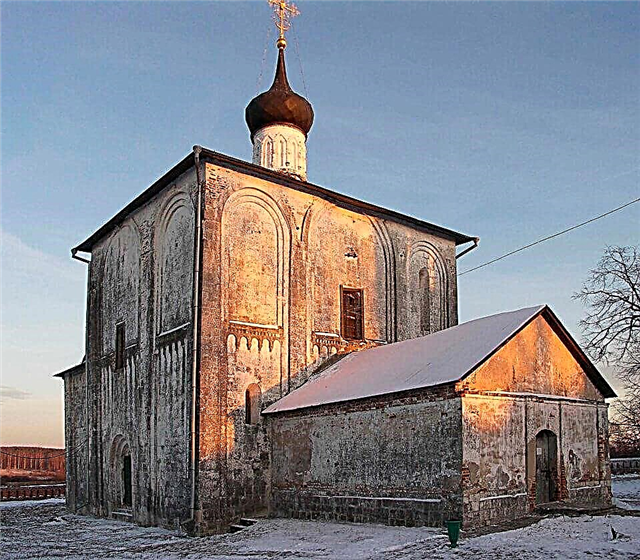
5 km from the city, where the Kamenka flows into the Nerl, there is a small village of Kideksha. Now there are several hundred inhabitants, and once there was the residence of Yuri Dolgoruky. At his behest, in 1152, a temple was erected in honor of Boris and Gleb.
According to legend, it was here that the brothers Boris and Gleb met before going to Kiev. This one-domed, four-pillar church with restrained decor and simple lines makes a stern, majestic impression even on the modern viewer.
Inside, there are still fragments of a fresco depicting brothers among the flowers and trees of the Garden of Eden. Yuri Dolgoruky's son Boris, his wife and daughter were buried in the church. During the Tatar-Mongol invasion and the Time of Troubles, the temple was badly damaged, but then it was restored.
Research and archaeological work is constantly being carried out in the church. Since 1992 it has been included in the UNESCO World Heritage List.
Shopping arcade
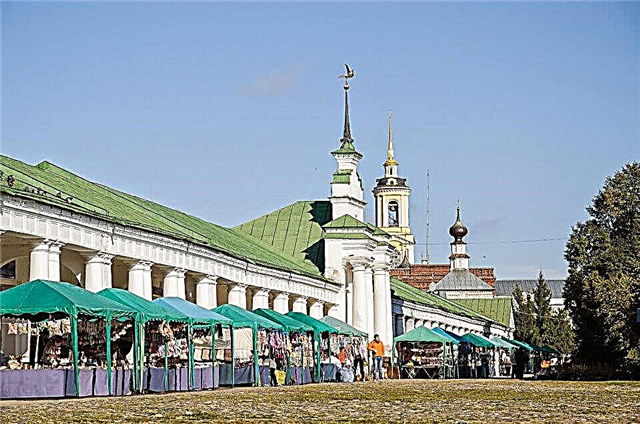
At the beginning of the 19th century, Gostiny Dvor was built in the center, taking as an example similar shopping malls in St. Petersburg. There were 100 shops here, which later turned into ordinary shops. It was one of the busiest places in the city.
And now Gostiny Dvor, which is an example of civil engineering and the Empire style, remains the center of the city's trade and tourist life. Unfortunately, the building has not been completely preserved in its original form, but the main gate with the old coat of arms remains, and there are still a lot of tourists here: counters with traditional souvenirs, mead and Pokrovsky gingerbread are placed in the galleries.
There is a restaurant and entertainment center nearby. In addition, not far from the shopping arcade, there are other attractions - the temples of the Lord's Entering into Jerusalem and the Ascension, the churches of Kazan and Constantine and Helena and other objects.
Resurrection and Kazan churches
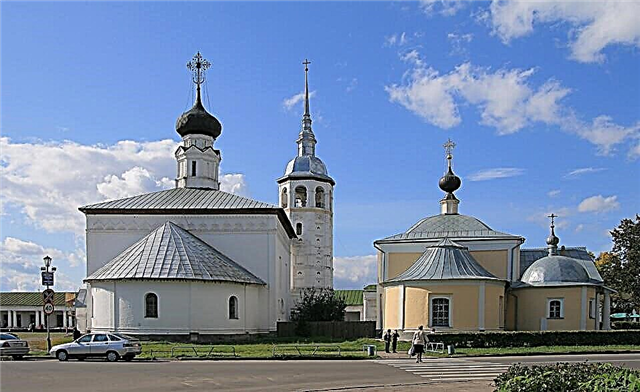
The Resurrection Church stands next to Gostiny Dvor on the Torgovaya Square. Therefore, its name was often added "to the auction". The wooden temple that stood here earlier burned down in 1719, and a year later a stone church was erected on this place.
This is a summer "cold" church, and services were held in it only during the warmer months. In order for parishioners to attend services in winter, later, in 1739, the Kazan Church was built nearby.
The tradition of placing paired winter and summer churches side by side was very common in this era.
The ensemble fits very harmoniously into the overall picture of the center and, together with Gostiny Dvor and the domes of churches, creates a unique atmosphere of this city. It is very easy to imagine how the city lived 100 years ago. That is why historical films are often shot at this place.
Tsarekonstantinovskaya and Sorrowful churches
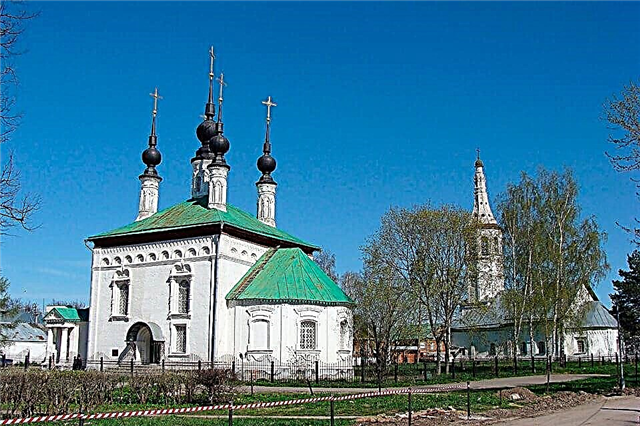
The Tsarekonstantinovskaya church is often called simply Tsareva by the townspeople. From the chronicles it is known that in its place once stood a wooden church, consecrated in honor of Tsar Constantine. Over time, it fell into disrepair, it was dismantled and built in stone in 1707.
On a high cube with a hipped roof, there are five elongated drums with the same long spiers and elongated crosses. The snow-white temple is decorated with a decorative cornice with arches made in the form of horseshoes, kokoshniks and carved frames on the windows. This is the last five-domed church in Suzdal.
In 1750, a warm Sorrowful Church was added to it. It consists of low stands with a gable roof. Next to it there is an elegant bell tower, decorated with decorative cornices with carvings and majolica balusters.
In 1923, the temples were closed and a garage was installed in them, and later a public toilet. In 1976 they were returned to the church, and in 1977 the rector of the church, Archimandrite Valentin Rusantsov and his community was completely restored.
Kamenka river
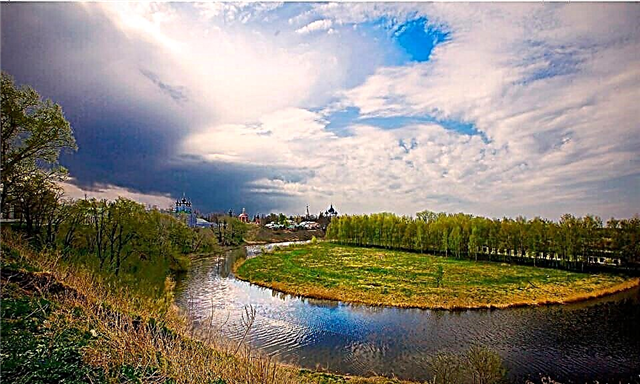
Kamenka is a river in the Vladimir region, which is the right tributary of the Nerl. Once it was deep and navigable. On Kamenka the ships went to the Nerl and further through the Oka and Volka to the Caspian Sea.
The river was part of the famous trade route, along which Suzdal merchants brought honey, timber, flax, furs and wax to overseas countries, and brought back silk, spices, gold and precious stones and other exotic treasures.
Once the water in the river was so clean and transparent that all the stones at its bottom were visible, hence the name "Kamenka". The main sights of the city are also located along its banks. Once upon a time the river also played an important defensive role.
Now it has become much shallower and is not navigable. But its picturesque shores still attract Suzdal residents and tourists. There are many hotels and guest houses here, with a view of its beautiful banks and domes of churches.
Entry-Jerusalem and Pyatnitskaya churches
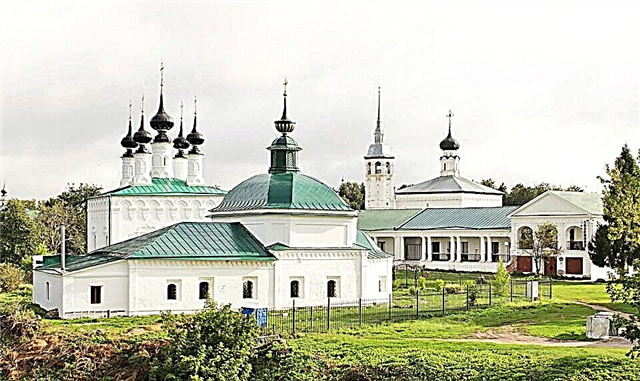
Another traditional paired ensemble of churches. The Entry-Jerusalem Summer Temple is located in the center, next to the Kremlin and the shopping area. On the site of an ancient, completely dilapidated wooden church, a stone building in the classical style was built in 1707.
Smooth walls with windows located at the same height and decorated with skillful carvings crowned the temple with five chapters mounted on high thin drums. However, by the end of the 18th century, the five-domed churches were almost not built, therefore, when they were doing repairs, four chapters were removed. They were restored during restoration in the 90s.
In 1772, the winter Pyatnitskaya was added to the church. At first it was called Nikolskaya, but since it was built instead of the wooden Pyatnitskaya, the new name did not take root. The temple is a large quadrangle with an octagon set on it with a large dome. It is crowned with an unusual shape in the form of an onion. Once upon a time there was a bell tower at the church, and the whole ensemble was surrounded by a low white-stone fence, which have not survived to this day.
Kresto-Nikolskaya church
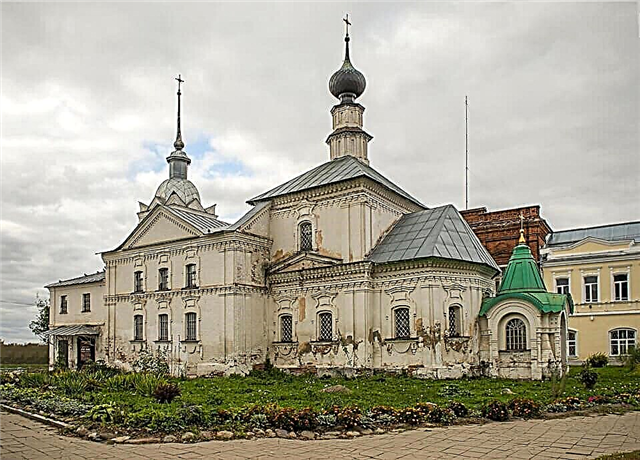
In 1654-1655 plague raged. According to tradition, the townspeople performed prayers for deliverance from this misfortune, and later a cross was erected on this place, and later they laid a wooden church of the Holy Cross with a chapel dedicated to the most popular saint in Russia - Nicholas the Wonderworker.
In 1770, a stone temple was built in its place. The church is located north of Gostiny Dvor and overlooks Lenin and Staraya streets.The building has a special two-color design, and if you look at it from different streets, it is difficult to imagine that this is one and the same building.
From the side of Lenin Street you can see the main part, painted yellow with white pediments and cornices, and from the Old Street you can see a light bell tower and a whitewashed refectory added in the 19th century. They obscure the cube of the main volume and give the impression of an outside building.
Lazarevskaya and Antipievskaya churches
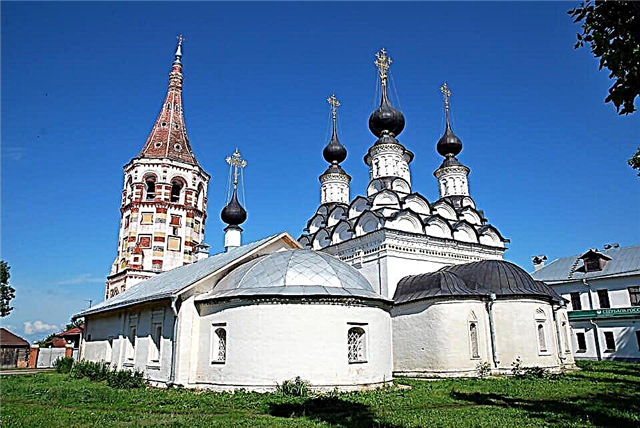
Lazarevskaya Church is one of the oldest stone buildings. It was built in 1667 on the site of the old wooden church of the same name. For the first time, decorative techniques were used in its design, which later became traditional for Suzdal churches.
The temple also impresses with its interior decoration. Divine services were held in it only in the warm season, and in 1745 a pair of winter temples, the Antipievskaya Church, were built. It has a more laconic design, but it stands out primarily for its bell tower with a concave hipped roof.
The bell tower was erected before the main building. It is one of the tallest and most beautiful buildings in the city, and its exterior was restored during the 1959 restoration in accordance with the decorative details typical of the 17th century.
Church of Kosma and Damian on Yarunova Gora
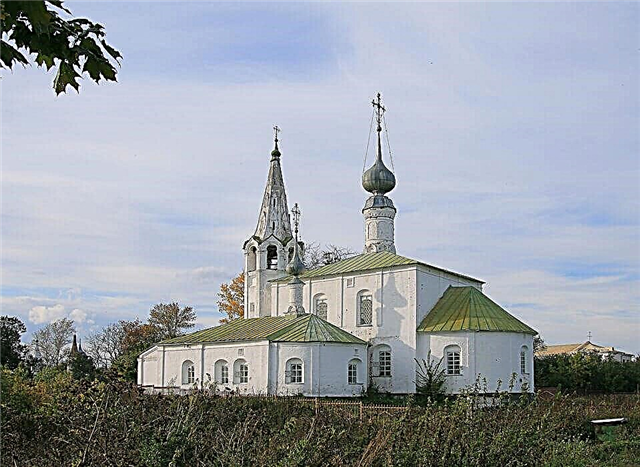
In the XII century, here, on the banks of the Kamenka River, the monastery of Kosma and Damian was located. By the 17th century, only one wooden church remained from it. In 1725 it was replaced by a stone church in honor of Kosma and Damian, or Kozmodemyanskaya church.
It was erected on the Yarunova Hill - the place where in pagan times there was a temple of Yarun. The church was erected on a hill so that it could be clearly seen from afar. And today an excellent view opens up from Lenin Street.
The church has an asymmetrical structure, which was often used during this era. A simple cube of the main building is crowned with only one dome on a high drum. On the one hand, a bell tower adjoins it, and on the other - a low side-chapel, also with one chapter.
Once the temple was surrounded by a low fence, and a stone staircase led to the river, but in our time the fence and staircase have not survived.
Smolensk and Simeonov churches
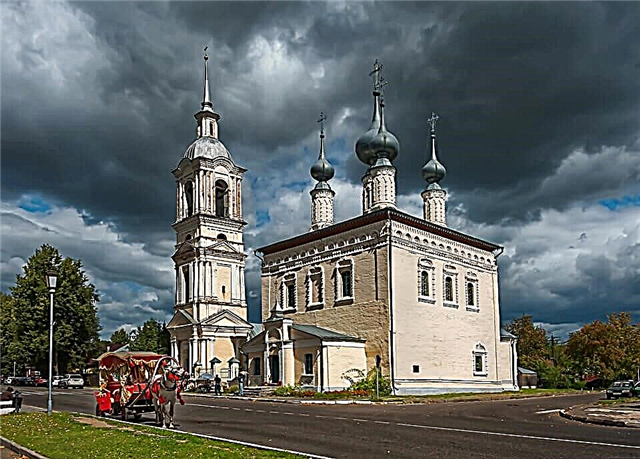
Artisans - masons, blacksmiths, weavers and tailors lived outside the walls of the Spaso-Evfimievsky Monastery, a settlement was formed here, which received the name Skuchilikha, either because of the "crowded" settlement of a large number of people, or because of the constantly crowding carts of traders from Yaroslavl, Vladimir , Moscow and Kostroma.
Next to the corner monastery tower, residents of the settlement erected a wooden church in honor of the Smolensk Icon of the Mother of God. In 1709, a stone one was built in its place. The five-headed light, elegant church stood on the road leading from Yaroslavl, and, as it were, was the gateway to the city from this side.
It was a summer, unheated temple. According to tradition, it was later supplemented with a warm side-altar - the church of Simeon the Stylite. At first it was also made of wood, and then, in 1749, it was replaced by a stone one.
This is a small temple, very restrained, without any special decorative elements. At the end of the century, the ensemble of churches was supplemented with a bell tower, connecting them with a gallery.
Kozmodemyanskaya and Holy Cross churches
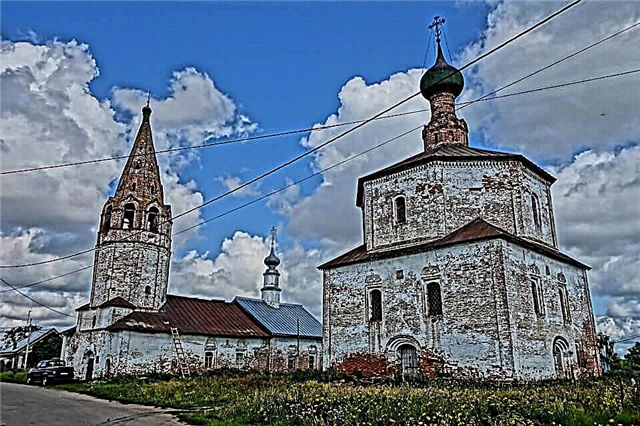
The ensemble, traditional for medieval Russia, is a pair of winter and summer churches located on the banks of the Kamenka, away from the central and most lively part of the city. Winter services were held in the warm Church of the Exaltation of the Cross. It was built in 1696 and consists of two cages, one of which is crowned with a dome, set on a high decorated drum.
The summer Kozmodemyanskaya church was added later. It is a one-dome structure with a beautiful patterned drum. Both churches are made in a rather restrained style, without a lot of decorative elements. Services have not been held in both churches for a long time and restoration has not been carried out for many years, which, incidentally, gives them a special charm.
Monument to Tarkovsky
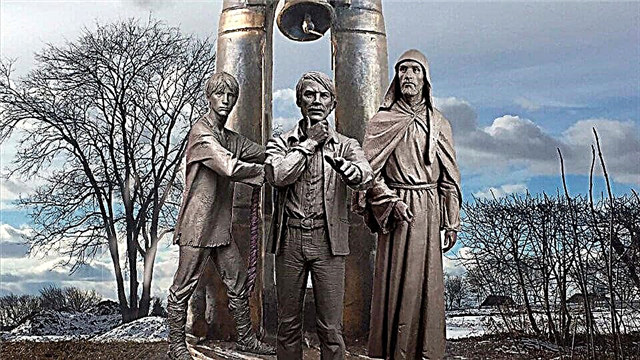
Is it worth explaining who Andrei Tarkovsky is? The film of this director "Andrei Rublev" is familiar to everyone. On July 29, 2017, the grand opening of the monument took place, the idea of which belongs to Nikolai Burlyaev and Maria Tikhonova. The 4.5-meter composition is installed next to the Spaso-Evfimiev Monastery.
The sculptor worked on it free of charge for three years and as a result, now this “symbol of unification” is an adornment of the city and an important reminder of “what Russian cinema can be and should be”.


